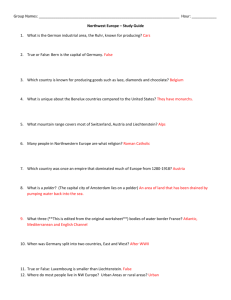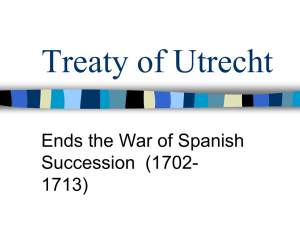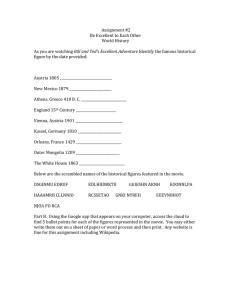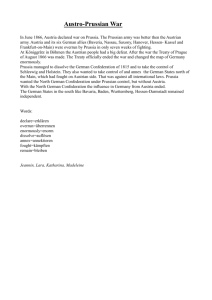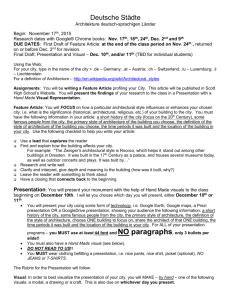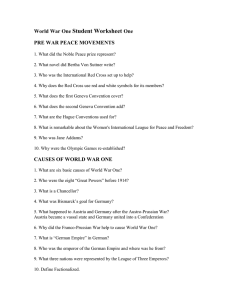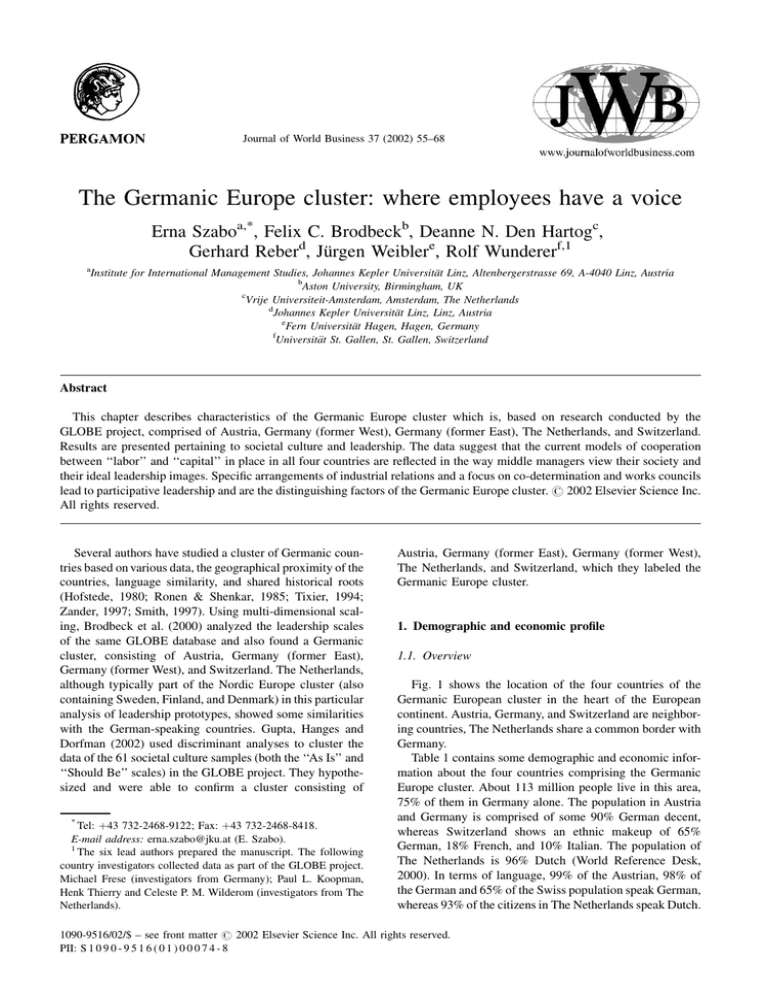
Journal of World Business 37 (2002) 55±68
The Germanic Europe cluster: where employees have a voice
Erna Szaboa,*, Felix C. Brodbeckb, Deanne N. Den Hartogc,
Gerhard Reberd, JuÈrgen Weiblere, Rolf Wundererf,1
a
Institute for International Management Studies, Johannes Kepler UniversitaÈt Linz, Altenbergerstrasse 69, A-4040 Linz, Austria
b
Aston University, Birmingham, UK
c
Vrije Universiteit-Amsterdam, Amsterdam, The Netherlands
d
Johannes Kepler UniversitaÈt Linz, Linz, Austria
e
Fern UniversitaÈt Hagen, Hagen, Germany
f
UniversitaÈt St. Gallen, St. Gallen, Switzerland
Abstract
This chapter describes characteristics of the Germanic Europe cluster which is, based on research conducted by the
GLOBE project, comprised of Austria, Germany (former West), Germany (former East), The Netherlands, and Switzerland.
Results are presented pertaining to societal culture and leadership. The data suggest that the current models of cooperation
between ``labor'' and ``capital'' in place in all four countries are re¯ected in the way middle managers view their society and
their ideal leadership images. Speci®c arrangements of industrial relations and a focus on co-determination and works councils
lead to participative leadership and are the distinguishing factors of the Germanic Europe cluster. # 2002 Elsevier Science Inc.
All rights reserved.
Several authors have studied a cluster of Germanic countries based on various data, the geographical proximity of the
countries, language similarity, and shared historical roots
(Hofstede, 1980; Ronen & Shenkar, 1985; Tixier, 1994;
Zander, 1997; Smith, 1997). Using multi-dimensional scaling, Brodbeck et al. (2000) analyzed the leadership scales
of the same GLOBE database and also found a Germanic
cluster, consisting of Austria, Germany (former East),
Germany (former West), and Switzerland. The Netherlands,
although typically part of the Nordic Europe cluster (also
containing Sweden, Finland, and Denmark) in this particular
analysis of leadership prototypes, showed some similarities
with the German-speaking countries. Gupta, Hanges and
Dorfman (2002) used discriminant analyses to cluster the
data of the 61 societal culture samples (both the ``As Is'' and
``Should Be'' scales) in the GLOBE project. They hypothesized and were able to con®rm a cluster consisting of
*
Tel: 43 732-2468-9122; Fax: 43 732-2468-8418.
E-mail address: erna.szabo@jku.at (E. Szabo).
1
The six lead authors prepared the manuscript. The following
country investigators collected data as part of the GLOBE project.
Michael Frese (investigators from Germany); Paul L. Koopman,
Henk Thierry and Celeste P. M. Wilderom (investigators from The
Netherlands).
Austria, Germany (former East), Germany (former West),
The Netherlands, and Switzerland, which they labeled the
Germanic Europe cluster.
1. Demographic and economic pro®le
1.1. Overview
Fig. 1 shows the location of the four countries of the
Germanic European cluster in the heart of the European
continent. Austria, Germany, and Switzerland are neighboring countries, The Netherlands share a common border with
Germany.
Table 1 contains some demographic and economic information about the four countries comprising the Germanic
Europe cluster. About 113 million people live in this area,
75% of them in Germany alone. The population in Austria
and Germany is comprised of some 90% German decent,
whereas Switzerland shows an ethnic makeup of 65%
German, 18% French, and 10% Italian. The population of
The Netherlands is 96% Dutch (World Reference Desk,
2000). In terms of language, 99% of the Austrian, 98% of
the German and 65% of the Swiss population speak German,
whereas 93% of the citizens in The Netherlands speak Dutch.
1090-9516/02/$ ± see front matter # 2002 Elsevier Science Inc. All rights reserved.
PII: S 1 0 9 0 - 9 5 1 6 ( 0 1 ) 0 0 0 7 4 - 8
56
E. Szabo et al. / Journal of World Business 37 (2002) 55±68
Fig. 1. The map of the region.
Dutch is a language of Germanic origin, but many other
languages have had their in¯uence on it over the centuries.
Together, these four countries generate a gross domestic
product of almost U.S.$3000 billion. A GDP per capita of
U.S.$24,123 positions the Germanic Europe countries in the
group of the wealthiest nations in the world. This fact is also
represented in the high rankings on the U.N. Human Development Index for each of the four countries. This index
measures the overall achievements within a country on three
basic dimensions of human development: longevity, knowledge and a decent standard of living. It is measured by life
expectancy, educational attainment and adjusted income per
capita in purchasing power parity (PPP) U.S. dollars.
Austria, Germany, and The Netherlands are member states
of the European Union. Germany and The Netherlands were
among the six founding members of the European Economic
Community (founded in 1957). Austria joined in 1995. The
three countries are also members of the EURO zone, in other
words they are among the 12 E.U. countries that will use the
EURO as common currency from January 2002 on. In
contrast to the other three countries of the Germanic Europe
cluster, Switzerland has repeatedly upheld its economic
autonomy in referenda. Despite this independence, the economic ties between Switzerland and the E.U. are quite strong.
1.2. Demographic and political characteristics
Austria and Switzerland are topographically dominated
by the Alps, while Germany ranges from the Alps in the south
to the Baltic and North Sea in the north. The Netherlands,
located to the northwest of Germany, show a completely
different, ¯at landscape with nearly half of the country below
sea level. But the Netherland's territory does not only consist
of the European part, it also includes several islands in the
Caribbean (The Netherlands Antilles and Aruba). In terms of
population, Germany is the country with the largest population in the E.U., whereas Austria, The Netherlands, and
Switzerland are much smaller. Compared to The Netherlands, Austria and Switzerland are less densely populated
because of the mountain regions.
Concerning the political constitution, Austria, Germany
and Switzerland are democratic republics with distinguished
features. The Federal Republic of Austria's constitution
provides for a federal republic embracing nine provinces
including the capital Vienna. Most effective power is at
the federal level, but the provinces have some latitude in
local administration. The national government consists of a
president whose functions are largely ceremonial, a cabinet
headed by a chancellor, and a bi-cameral legislature.
Austria
Germany
The Netherlands
Switzerland
Germanic Europe Cluster
World
Germanic Europe/World
Surface area
(`000 km2)
Population
(Millions)
Life
expectancy
(Years)
Female
ratio (% of
population)
GDP
(Billions
U.S.$)
GDP per
capita
(PPP U.S.$)
Human
development
indexÐworld
ranking
Agricultural
value added
(% GDP)
Manufacturing
value added
(% GDP)
Trade
(% GDP)
84
357
41
41
523
133,572
0.0039
8.1
82.0
15.8
7.2
113.1
5862.7
0.019
77.9
77.6
78.0
78.8
77.8
66.7
1.17
52.3
51.3
50.6
51.1
51.3
49.6
1.03
208.2
2111.9
393.7
258.6
2972.4
30,351.4
0.098
25,089
23,742
24,215
27,171
24,123
6,980
3.456
16
17
8
11
13.5 (median)
81
High
n.a.
7
n.a.
n.a.
±
4
±
n.a.
24
n.a.
n.a.
±
21
±
91
57
117
76
69
52
1.33
Sources: Human Development Report (2000), World Development Report (2000±2001), World Desk Reference (2000).
a
n.a.: not available.
E. Szabo et al. / Journal of World Business 37 (2002) 55±68
Table 1
Economic and demographic pro®lea
57
58
E. Szabo et al. / Journal of World Business 37 (2002) 55±68
The upper house, which represents the provinces, is
restricted to a review of legislation passed by the lower
house and has only delaying powers. Each province has an
elected legislature and an administration headed by a governor. The centralization of the Austrian political system
becomes even stronger through the cooperation with the
(also) centralized social partners (see section on Industrial
Relations). The term ``corporate state'' (Crispo, 1978) ®ts
Austria the best in comparison to the other countries in the
Germanic Europe cluster.
In contrast to the Austrian system, the constitution of the
Federal Republic of Germany de®nes a federal republic to a
much higher degree. The states (``LaÈnder'') have a high
degree of discretion, especially concerning cultural affairs
such as the education system. Germany is, in both the
political and industrial relations area, a decentralized nation.
The LaÈnder are at the heart of Germany's political life. Each
Land has its own elected parliament and largely controls its
own ®nances. The former German Democratic Republic
(East Germany) became a part of the republic after the
German Reuni®cation in 1990. The two German nations
did not merge but rather West Germany took over in all
respects (Brodbeck & Frese, in press). Berlin was reinstalled
as the capital of the newly united Germany.
The Swiss Confederation has been a federal republic since
1848, based on the principle of subsidiarity: ``[. . .] only what
the individual family cannot do, should the community do;
only what the community cannot do, should the canton do;
only what the canton cannot do, should the Federal State do''
(Hilb & Wittmann, 1992: 525). Switzerland is one of the few
countries in the world with substantial elements of direct
democracy. According to the political scientists Riklin and
MoÈckli, ``Switzerland is considered worldwide to be the
country with the most extended, differentiated and traditional institutional structure of direct democracy'' (Riklin &
MoÈckli, 1983: 39). The government is constituted by the
Federal Council which is a collegial authority. In other
words, all important decisions are made by the council as
a whole and there is no actual head of government. The
president of the confederation, who is elected from among
the members of government for a period of just one year
(after which another member accedes to this of®ce), is not a
head of state but a primus inter pares. Switzerland is the only
country in the world where a collegial authority serves as
head of state, as head of the government and as the government itself. The collegial government is limited insofar as
referenda have to be administered for all important issues.
Their outcome is binding, even if the government had
recommended an opposite course of action. The seat of
the government is in Berne.
In contrast to Austria, Germany and Switzerland, the
Kingdom of The Netherlands is a constitutional monarchy
with a parliamentary system. Legislative power is vested in
parliament and the monarch (currently Queen Beatrix) has
only nominal power. The state capital is Amsterdam,
whereas the seat of government is located in The Hague.
1.3. Economic characteristics
Germany is Europe's foremost industrial power and after
the U.S., Germany is the world's second biggest exporter
(World Desk Reference, 2000). The economy's strongest
sectors are automobiles, heavy engineering, electronics and
chemicals. Although Germany is the major economic force
of the four countries forming the Germanic Europe cluster,
the economies of the smaller three countries have their
strengths. Despite its small size, the Dutch economy is
the 15th largest in the world. The Netherlands is also the
world's sixth largest source of investment as well as the sixth
largest exporting country (with IMF ®gures showing only
the U.S., Germany, Japan, Great Britain and France larger
exporters in 1998). Over the last two decades, direct and
commercial services have become the largest economic
sector in The Netherlands, with some 64% of the Dutch
workforce currently employed in the service sector. Most
service-sector companies work predominantly in the domestic market. In contrast, the Dutch manufacturing sector has
an international export focus, as well as the location of
production plants and tendency to join forces with foreign
companies. The main manufacturing industries are chemicals, food processing, and metalworking. The port of
Rotterdam imports and re®nes huge quantities of crude
oil for use all over Western Europe. In both Austria and
Switzerland, the service sector accounts for a considerable
portion of the GDP. Tourism is one of the best-known service
areas: 11.1 million visitors travel to Switzerland each year
and 16.6 million travel to Austria (World Desk Reference,
2000). In contrast to other countries where hotels tend to be
large and parts of major hotel chains (e.g. Holiday Inn,
Hilton), most of the Austrian and Swiss hotels are family
operated and, in some cases, have been family owned and
operated for a number of decades or even centuries. Switzerland's most important products are machines, electronics,
chemicals, pharmaceuticals, precision instruments, watches
and clocks, and jewelry. The ®nancial services also play a
special role. Austria has strong steel and chemical industries,
along with electrical engineering, car assembly, textiles, and
wood processing industries.
All four countries have relatively few natural resources,
making them heavily dependent on foreign trade. Austria
draws on timber, some metals and minerals, salt, and a dense
river network serving as the base for hydro-electric power
and mass transportation. In a referendum in 1978, a close
majority of the Austrian population voted against the use of
nuclear power. Germany's natural resources include coal,
oil, copper, salt, potash, tin and nickel. The country imports
more than 50% of its energy needs. Unlike other European
countries (e.g. France), Germany did not heavily invest in
nuclear power. The Netherlands possess natural gas reserves
in the northern part and there is some oil production from
offshore drilling in the North Sea. Finally, Switzerland does
not possess any considerable raw materials apart from water.
The country is sometimes called Europe's water tower, as it
E. Szabo et al. / Journal of World Business 37 (2002) 55±68
is the source of western Europe's largest rivers: the Po, the
Rhine, the Rhone, and the Inn-Danube (World Desk Reference, 2000).
The ®rms in the Germanic Europe cluster can also be
compared through the lens of size and ownership. The
predominant feature of Austria and Switzerland's economies
is their high proportion of small and medium-size enterprises. Most ®rms in both countries are traditional small
businesses that employ a substantial portion of the population. These businesses are under unincorporated sole proprietorships. Austria is a country where business did not go
through a ``big is better'' stage. Only in the wake of E.U.
membership have mergers taken place in some sectors, e.g.,
the ®nancial sector. In contrast, Switzerland's international,
global acting companies are well known world wide, for
example UBS (®nance), Nestle (food) or Novartis (pharma).
The Netherlands host many blue-chip multinationals,
including Philips and Shell. The Royal Dutch/Shell Group
(with joint U.K. and Dutch ownership) is the world's sixth
largest corporation (World Desk Reference, 2000). In
Germany, the economy is largely in private hands; major
banks and businesses are privately owned. DaimlerChrysler
is among the world's 20 largest corporations.
There are strong economic ties among the countries of the
Germanic Europe cluster, in particular between Austria, The
Netherlands and Switzerland on the one hand, and Germany
on the other hand. Imports of the three smaller countries
from Germany range from 22% (Netherlands) to 42%
(Austria). Exports to Germany amount to 35% for Austria,
26% for The Netherlands, and 22% for Switzerland (World
Desk Reference, 2000). Interestingly enough, Germany
imports more from The Netherlands than from the United
States or Great Britain. Due to historical reasons, Austria's
economy is closely linked to its neighbor Germany. The link
dates back to the time between the two World Wars when
Germany's economic in¯uence on impoverished Austria
grew substantially; by the 1930s, commercial law in Austria
and Germany had become almost identical. The close ties to
the German market economy remain today and facilitate
business transactions between the two countries. Already
long before the introduction of the EURO, the Austrian
Schilling had a stable exchange rate with the German Mark.
The collapse of the Soviet communist system which had
dominated Central and Eastern Europe had an economic
impact mainly on Germany since it led to the reuni®cation of
Germany and the process of rebuilding the economy in the
eastern states. Since 1990, billions of U.S. dollars (about
650 billion between 1991 and 1995 alone) have been transferred to the new provinces, mainly to modernize the
economy, to establish health care and social welfare funds,
and to ®ght unemployment. Despite this aid, cultural and
social problems still exist between the former East and West
Germans. It can also be said that one of the weaknesses of the
German economy was to underestimate the costs of updating
the highly inef®cient economy. The unemployment rate in
the former East Germany was as high as 18% in 1998
59
(Kaufmann, 2000). Rebuilding the country and reducing
the high unemployment rate remains one of the biggest
challenges in the years to come. In addition to Germany,
Austria's economy was also heavily in¯uenced by the
changes of 1989. Geographically, Austria was favorably
located to regain its role as an important economic player
in the region of Central Europe. Most notably, in the
beginning of the 1990s, Austria's exports and direct foreign
investments increased drastically. Austrian businesses also
began taking advantage of cheap labor and many manufacturers shifted their production sites across borders. Vienna's
proximity to the Central and Eastern European markets also
means that many international ®rms use the city as a base
from which to coordinate Central and Eastern European
operations (Smith, 1992: 108).
1.4. Industrial relations
Strikes seldom occur in the countries of the Germanic
Europe cluster. In contrast, the systems give the employees
``a voice'' (Hirschman, 1970). The relationship between
``labor'' and ``capital'' is based on the assumption that the
basic aims of economic dealing can be better attained
through cooperation and coordinated action rather than by
confrontational means, such as strikes or lockouts. We ®nd
consensus models in all four countries. The models differ
from each other substantially, but they have contributed to
social peace which was essential for the countries' reconstruction after the destruction of World War II.
The industrial relations models of the four countries are
summarized in Table 2. Austria's system of cooperation
(Social and Economic Partnership Model) begins at the
national level and has been transferred down into the organizations. It is a system of economic and social cooperation
between the representatives of employers (chamber of commerce), employees (chamber of labor), farmers (chamber of
agriculture), unions, and government. Cooperation, based on
the principle of voluntarism, is carried out informally and
could not function unless the sections of the working population belong virtually en-bloc to their representative institutions (Szabo & Reber, in press). Thus, membership to the
chambers of commerce, labor and agriculture is obligatory
(in 1996 the members of the different chambers voted in
large numbers for a retention of obligatory membership).
Austrian unions are closely linked to political parties and are
in¯uenced by social ideologies, including Catholic and
socialist ones (Tannenbaum et al., 1974). Since Austria
became member of the E.U., the role of the social partnership has somewhat decreased. After political changes in the
country, there are even voices who speak of the end of social
partnership. But although its role is weaker than in the past,
its ideas are still felt to be relevant and call for a modernization of the system rather than for destruction.
In Germany, the doctrine of social market economy
(``soziale Marktwirtschaft'') de®nes obligations of government, trade unions and companies to maintain public
60
E. Szabo et al. / Journal of World Business 37 (2002) 55±68
Table 2
Industrial relationsÐforms of cooperation including government
Austria
Germany
The Netherlands
Switzerland
National level
Social and economic
partnership
Consultations
Socio-Economic council
Peace agreement
Industry level
Collective bargaining
Collective bargaining
Labor foundation
Collective bargaining
Collective bargaining
Company level
Works councils
33% labor on
supervisory boards
Works councils
Works councils
Co-determination Act: 50%
labor on supervisory boards
Coal and Steel Industry: one labor
representative on management board
welfare, social justice, and cooperative industrial relations.
The use of capital is limited by the principle of social
responsibility which is anchored in the German constitution.
A good example is the wage bargaining process. It is simple
in structure (two partners negotiate: one trade union and one
employer), predictable (based on a given time-table of industries and states) and stable (wage bargaining has the force of
law, and strikes occur mainly in particular seasons of the year,
c.f., Lawrence, 1994). Nevertheless, collective bargaining in
Germany is more aggressive than in Austria. This may be due
to the dominance of industry-speci®c unions.
In The Netherlands, close consultation takes place
between government, industry and trade-unions. Stability
is maintained by close and regular contact in the SocioEconomic Council between the trade unions, employers'
associations, and independent consultants appointed by the
government. The two sides of industry also have permanent
contact in the Labor Foundation. The government interferes
as little as possible in industrial relations.
In Switzerland there is a long tradition with regard to
cooperative relations between employers and employee
representatives (c.f., Hilb & Wittmann, 1992). There is no
legislation on strike, lock-out or boycotts and union density
is relatively low (27% compared to 46% in Austria, for
example, c.f., Morley et al., 1996). Industrial relations by
confrontation are not valued by the partners. The willingness
to compromise is best exempli®ed in the Peace Agreement
of 1937, signed by the trade unions and the employers'
association. Today the peace duty is an element in most
collective agreements. Uncertainty, which is the concomitant of every con¯ict, should be avoided like in other ®elds
(Hilb & Wittmann, 1992).
Co-determination is another element of industrial relations. In Austria and Germany, co-determination concept is
regulated by law and takes the form of two-tiered management structures. In Germany, co-determination calls for an
equal distribution of the employer and the labor side on the
supervisory board of large enterprises which sets corporate
politics, approves major investments, mergers, expansion
and plant closures. The employer side can only overrule the
resistance of the labor side in deadlock situations. In the coal
and steel industry, for example, one member of the manage-
Works councils
ment board is directly appointed by the labor representatives
on the supervisory board and heads the personnel department. In Austria, co-determination takes the form of onethird employees' representation on supervisory boards.
Finally, works councils in organizations are given three
kinds of rights: the right of information, the right of consultation, and the right of consent, depending on whether or
not economic, social or personnel affairs are concerned.
Works council members are elected by the employees. In
practice, they often have close union ties.
To foreigners these systems of cooperation may appear
strange and overburdened with formal procedures. However,
they are important contributing factors to the stable and solid
economical and social developments in the four countries of
the Germanic Europe cluster. Like other European countries,
there are ongoing discussions as to whether the high labor
standards can assure the countries' competitiveness in world
markets. The Union of Industrial and Employers' Confederations of Europe (UNICE) argues that the high labor standards
in Europe, compared to the U.S., for example, are contributing
factors to the problems facing European ®rms. In contrast, the
European Trade Union Confederation (ETUC) argues that
European ®rms can best compete with a highly skilled, wellpaid and highly trained labor force (Gill, 1996).
2. History and religious foundations
2.1. Historical development
The region of today's Germanic Europe dates back to
Charlemagne's (Charles the Great) reign in the eighth
century, when it became a united empire stretching across
Western Europe. In the centuries to come, several dynasties
reigned in the region and the territorial boundaries of their
empires varied. There have been continuous battles over the
lands of today's Germanic Europe without any success for
uni®cation and not even the 20th century is an exception to
this pattern. In the following pages, we will highlight a few
major historical facts and events.
The Habsburg dynasty, who originated from Switzerland,
dominated Austria's history from the 13th century up to the
E. Szabo et al. / Journal of World Business 37 (2002) 55±68
beginning of the 20th century. They were very successful in
enlarging their territories through strategic marriages. The
empire became known as the ``Holy Roman Empire of the
German Nation''. In 1522, the dynasty split into a Spanish
and an Austrian line. Having reversed Ottoman thrusts into
Europe, Austria acquired new territories and emerged as a
major European power in the 17th century. Its lands, which
were inhabited by a rich body of people from different
nationalities, reached from The Netherlands in the West
to Sicily in the South and Poland in the East. Conquests in
Central America under Charles V led to the notation of the
empire in which ``the sun never sets''.
The Netherlands historical development followed different patterns, although it was part of the Holy Roman Empire
for a short period. An important part of its history involves
the early decentralization of power that cities and citizens
gained. Around 1300, the cities of Holland (the part of the
country along the western coast) received municipal rights.
These rights allowed a city to govern itself and to determine
its own jurisdiction. It was customary to consult citizens of
the city before acting upon expensive plans. A more centralized government was established in the early 15th century, as the cities adopted a form of capitalism. In the 16th
century, The Netherlands were conquered by the Spanish
line of the Habsburgs and remained part of the Holy Roman
Empire until 1648. The 17th century is described as the
Dutch Republic's Golden Age. Merchants established trading societies, such as the East Indies Company in 1602,
followed by the West Indies Company in 1621. In 1625,
New Amsterdam (New York) was established. Holland was
also the sole country with a permanent foothold in Japan. In
the 18th century the Republic showed decay in many
domains that had ¯ourished during the Golden Age. France
occupied the Republic end of the 18th century, shortly before
Napoleon went to war with many other European countries.
However, in 1814, the country became independent again:
``The Netherlands'' was born and trade began to ¯ourish
once more. As earlier in history, counties and cities acquired
relatively strong autonomy to administer their own affairs
(Thierry et al., in press).
Switzerland became a part of the Holy Roman Empire in
the Middle Ages. However, some dynasties succeeded in
taking over territories and acting as sovereigns. Switzerland
became de iure independent in 1648 and more and more
political units gathered to form the Confderatio Helvetica, a
civilian society which holds up to the present day (Weibler &
Wunderer, in press).
Finally, while Austria was a monarchy for centuries,
today's Germany was split into a number of different states.
Germany, as we know it today, is thus a very young nation. It
was founded in 1870 when Prussia won a military victory
over France and the Prussian King William I was proclaimed
German Emperor in Paris. Austria, i.e., the House of Habsburg, was excluded from Bismarck's (who had taken charge
of Prussian policy in 1862) idea of a ``Little German
Solution'' and it remained a nation of many peoples (``Viel-
61
voÈlkerstaat'') with developing national con¯icts, which
®nally led to the beginning of World War I (1914±1918).
Initially, the war began as an Austrian internal issue triggered by the assassination of the successor to the throne by a
Serbian nationalist. The con¯ict quickly spread across Europe. Its main rivals were Austria and Germany on the one
side and the ``Triple Entente'' (the nucleus of the Allied
Powers: Great Britain, France and Russia) on the other side.
The Netherlands upheld neutrality which kept the country
largely outside the war. After the victory of the Entente and
the end of the war, Austria and Germany were obliged to
accept the terms de®ned in the Treaty of Versailles. The
Austrian empire was dissolved and both countries became
republics. This provided the foundation for today's democracies. The economic crises of the postwar years, however,
led to unstable economic and political conditions and in the
1930s to civil war in Austria and the rise of the National
Socialist (Nazi) party in Germany.
The Nazi regime began in Germany in 1933, when Adolf
Hitler was proclaimed Chancellor. The ideal of one German
nation became more and more popular with the notion ``one
people, one empire'' (``Ein Volk, ein Reich'') in the megalomaniac political program of the ``Third Reich'' (Brodbeck
& Frese, in press). What followed was World War II and one
of Europe's darkest periods in history, including the holocaust and massive destruction of huge parts of the continent.
In 1938, Hitler formally incorporated Austria's territory into
the German Reich. Historians have been debating since
whether or not the invasion was a hostile annexation by
the Germans or a voluntary joining (``Anschluû'') by the
Austrians (only recently has the second version become
more commonly accepted). The Netherlands were conquered by the Germans in 1940. Switzerland succeeded in
remaining neutral.
After the victory of the Allies and the end of the war in
1945, Europe's economy was stimulated with international
help. The Marshall Plan enabled a successful recovery. In the
decades after World War II, Austria, The Netherlands, Switzerland, and West Germany developed into prosperous countries with membership in various international organizations,
e.g., the OECD (Organization for Economic Co-Operation
and Development) and the OSCE (Organization for Security
and Co-Operation in Europe). Switzerland, unlike the three
other countries, became neither a member of the European
Union nor the United Nations, yet has played an active role in
U.N. organizations. Of®cially, however, autonomy and sovereignty continued to be her de®ning marks.
The period after World War II also brought the separation
of Germany into two parts. When the ``cold war'' between
the communist and the western world began, two very
different German nations emerged. The Federal Republic
of Germany (also termed West Germany) was embedded in
the western economic system and the NATO military alliance. The German Democratic Republic (also termed East
Germany) became part of the Communist Economic System
(COMCON) and the Warsaw Pact. In 1990, four decades
62
E. Szabo et al. / Journal of World Business 37 (2002) 55±68
after the separation, the constitutional ``Law of Reuni®cation'' (established in 1949) formed the legal basis on which
the German unity was reestablished. The symbolic act of the
fall of the Berlin Wall uni®ed Germany.
2.2. Catholicism and Protestantism
Austria is a predominantly Catholic country (78% Roman
Catholics, 5% Protestant). In contrast, religious af®liation
is more equally distributed in the other three countries
(Germany: 35% Roman Catholics, 36% Protestant; The
Netherlands: 36% Roman Catholics, 27% Protestant;
Switzerland: 46% Roman Catholics, 40% Protestant). The
northern part of Germany is largely Protestant whereas the
south and southwest, in particular Bavaria, have strong
Catholic traditions (World Desk Reference, 2000). Growing
numbers of citizens in all four countries have of®cially left
the church to declare themselves as non-religious.
3. The GLOBE data
3.1. Methodology and samples
This study involves the collection of data from middle
managers in Austria, Germany (former East and West), The
Netherlands, and Switzerland (German-speaking part). Data
were collected in the food processing and ®nancial services
sectors. In Germany and Switzerland, data were also gathered in the telecommunications sector. Organizations were
contacted directly by the researchers to ascertain willingness
to participate in the study prior to the questionnaires being
distributed to middle managers.
Each questionnaire contained a description of the
GLOBE project including instructions for completion.
169 questionnaires were completed in Austria, 456 in Germany (403 in the former West, 53 in the former East), 287 in
The Netherlands, and 321 in Switzerland. The average age of
the respondents was 43 years, 12% of which were female.
The questionnaire is the ®nal product of a process of
cross-cultural validation, including Q-sorts and translation
and back translation of questionnaire items (Hanges et al., in
press). The Austrian, German and Swiss respondents were
native speakers of German and therefore completed versions
of the original GLOBE questionnaire translated into German. All respondents in The Netherlands were native speakers of Dutch and thus ®lled out the Dutch version. The
managers were asked about their perceptions of ``As Is''
practices and on ``Should Be'' espoused values pertaining to
the nine societal and organizational dimensions de®ned
within the GLOBE project. The same managers also evaluated characteristics and behaviors contributing to or inhibiting from outstanding leadership. All questionnaire items
consisted of 7-point Likert-type scales.
3.2. Results concerning societal practices and values
Fig. 2 and Table 3 show the scores of the nine societal
culture dimensions for the Germanic Europe cluster. The
individual country scores in Table 3 represent the average of
Fig. 2. Germanic Europe cluster's societal culture scores.
Table 3
Country means for globe societal culture dimensions
Austria
Germany
(Former West)
Germany
(Former East)
The
Netherlands
Switzerland
Germanic europe cluster
Gap between ``As Is''
and ``Should Be''
As Is
Uncertainty avoidance
Future orientation
Power distance
Institutional collectivism
Humane orientation
Performance orientation
Group and family collectivism
Gender egalitarianism
Assertiveness
5.16
4.46
4.95
4.30
3.72
4.44
4.85
3.09
4.62
5.22
4.27
5.25
3.79
3.18
4.25
4.02
3.10
4.55
5.16
3.95
5.54
3.56
3.40
4.09
4.52
3.06
4.73
4.70
4.61
4.11
4.46
3.86
4.32
3.70
3.50
4.32
5.37
4.73
4.90
4.06
3.60
4.94
3.97
2.97
4.51
5.12
4.40
4.95
4.03
3.55
4.41
4.21
3.14
4.55
1.66
0.61
2.44
0.66
1.93
1.49
0.95
1.77
1.48
Should Be
Uncertainty avoidance
Future orientation
Power distance
Institutional collectivism
Humane orientation
Performance orientation
Group and family collectivism
Gender egalitarianism
Assertiveness
3.66
5.11
2.44
4.73
5.76
6.10
5.27
4.83
2.81
3.32
4.85
2.54
4.82
5.46
6.01
5.18
4.89
3.09
3.94
5.23
2.69
4.68
5.44
6.09
5.22
4.90
3.23
3.24
5.07
2.45
4.55
5.20
5.49
5.17
4.99
3.02
3.16
4.79
2.44
4.69
5.54
5.82
4.94
4.92
3.21
3.46
5.01
2.51
4.69
5.48
5.90
5.16
4.91
3.07
1.66
0.61
2.44
0.66
1.93
1.49
0.95
1.77
1.48
E. Szabo et al. / Journal of World Business 37 (2002) 55±68
Mean scores
63
64
E. Szabo et al. / Journal of World Business 37 (2002) 55±68
the individual scores aggregated to the society level. The
cluster scores are the average of the means of the ®ve country
samples.
As shown in Fig. 2, the scores of the societal culture
practices (``As Is'') in the Germanic Europe cluster are high
on the dimensions uncertainty avoidance (5.12), power
distance (4.95) and assertiveness (4.55), and low on gender
egalitarianism (3.14) (scores are de®ned as ``high'' when
>4.5 and as ``low'' when <3.5). The other societal culture
dimensions are at mid-range level, based on an average score
of 4. The cluster is at a ®rst glance characterized by a strong
tendency for standardization and rules, hierarchy, assertiveness, and gender inequality.
These ®ndings need to be adjusted by contrasting the
Germanic Europe Cluster with the societies in the other nine
cultural clusters found by the GLOBE project. Such a
comparative analysis was conducted by Gupta et al.
(2002) who found that ``Germanic Europe shows higher
practices of performance orientation, uncertainty avoidance,
future orientation, and assertiveness than many other clusters. This region is also characterized by relatively low levels
of institutional collectivism, group and family collectivism,
gender egalitarianism, and humane orientation'' (p. 23).
Concerning the power distance dimension, the comparative
analysis shows the Germanic Europe cluster at a medium
level.
Taking both the absolute scores and the comparative
analysis into account, the Germanic Europe cluster is,
compared to other clusters, characterized by practices with
a stronger tendency for standardization and rules, higher
levels of assertiveness, and more gender inequality. These
®ndings correspond with Hofstede's (1980) results, who
found high uncertainty avoidance for Austria (uncertainty
avoidance index UAI 70 on a scale between 8 and 112),
Germany (UAI 65), and Switzerland (UAI 58).
Hofstede's masculinity dimension (uniting gender differentiation, gender discrimination and a tough-tender component) also places Austria (masculinity index MAS 79 on a
scale between 5 and 95), Germany (MAS 66), and Switzerland (MAS 70) among the masculine countries. In his
study, The Netherlands were slightly lower on uncertainty
avoidance (UAI 53) and drastically lower on the masculinity index (MAS 14).
Societal cultural practices and values do not always go
parallel. Differences may re¯ect societal change or the
``ideal society'' without tendencies for change. The value
(``Should Be'') dimensions future orientation (5.01), institutional collectivism (4.69), humane orientation (5.48), performance orientation (5.90), group and family collectivism
(5.16) and gender egalitarianism (4.91) show high scores,
whereas uncertainty avoidance (3.46), power distance (2.51)
and assertiveness (3.07) are low.
Guptaet al.'s (2002) comparative analysis shows that the
Germanic Europe cluster, compared to other clusters, is
characterized by higher levels of desired gender egalitarianism than most other clusters, lower levels of envisioned
uncertainty avoidance, future orientation, group and family
collectivism, and assertiveness. There exist no signi®cant
cross-cluster differences for the dimensions humane orientation and power distance.
The value dimensions that are indeed different from the
other clusters and have clearly high or low levels are
uncertainty avoidance, assertiveness (low), and gender egalitarianism (high). Future orientation and group and family
collectivism are, although high in absolute terms, lower than
in many other clusters.
When comparing the ``As Is'' and ``Should Be'' scores for
each of the dimensions directly, it is interesting that in
particular those dimensions that are very high or very low
in terms of practices show the exact opposite tendency for
values. For instance, practices of strong uncertainty avoidance are contrasted by values of high uncertainty tolerance
(difference between ``As Is'' and ``Should Be'': 1.66).
Similarly, gender discriminating practices go along with
values of more equal rights for women (difference:
1.77). Women comprise about 40% of the labor force in
Austria, Germany and Switzerland, but they are mainly
concentrated in sales, agriculture and unskilled manufacturing. Females hold about 25% of parliament seats. These
numbers support the low level of gender egalitarianism
found in the ``As Is'' data. One might speculate that what
our (predominantly male) respondents articulated in the
``Should Be'' questionnaire is likely to be espoused values
rather than enacted ones. There are indicators, however, that
suggest slow progress toward enacted values, in other words,
toward more gender equality (Innreiter-Moser, 1999).
Table 3 indicates that there are some country-speci®c
differences for the societal culture dimensions. In most cases
it is the Dutch managers who evaluate their society differently from managers in the other countries of the cluster. In
terms of practices, there is a somewhat weaker tendency
toward uncertainty avoidance (4.70), power distance (4.11)
and group and family collectivism (3.70), as well as a
stronger tendency toward gender equality (3.50). The results
for uncertainty avoidance and gender egalitarianism support
Hofstede's (1980) ®ndings. In terms of values, the differences between The Netherlands and the other four countries
basically disappear.
The two German samples also show some variance. When
interpreting these differences one should keep in mind that
the process of reuni®cation created an asymmetric situation.
It was not a cultural merger. Instead, the East German system
was substituted by the West German system virtually over
night. Thus, the former East German respondents' views
could be in¯uenced by the ``modernization shock''. The two
samples hardly differ from each other on practices. This is
surprising as one might assume that former East and West
Germans have developed somewhat different societal cultures due to the differential political, economical and societal environments they lived in during the 40 years of the cold
war. In terms of values, the managers from former East
Germany hold, they rate uncertainty avoidance (3.94) higher
E. Szabo et al. / Journal of World Business 37 (2002) 55±68
than their counterparts from the former West (3.32), and in
fact highest of all ®ve country samples. This ®nding can be
explained by the ongoing and still drastic economic and
political changes originating from the fall of the iron curtain
in 1989 and the subsequent reuni®cation of Germany. The
scores of the former East German sample are likely to re¯ect
the dif®cult change process and as a consequence, the
citizens long for more stability in their lives. Another
difference between former East and West German respondents concerns the dimension future orientation. On the one
hand, managers of the former East German sample perceive
future orientation practices in German society more critically (indicated by lower scores) than their West German
counterparts. On the other hand, former East Germans value
higher levels of future orientation than West Germans do.
High future orientation values are typical for societies which
hope to bene®t from future developments. This expectation
seems to be more dominant for East Germans than for
West Germans. Former East Germans use the higher living
standard of the West as an upward comparison reference.
In contrast, former West Germans are more skeptical about
the future and more inclined to preserve the present status
quo.
3.3. Results concerning outstanding leadership
Fig. 3 provides an overview of the six second-order
leadership factors which are based on 112 leadership attributes ranked by the middle managers in our samples on a
scale between 1 (attribute greatly inhibits a person from being
an outstanding leader) and 7 (attribute contributes greatly
to a person being an outstanding leader). Therefore, the
®ndings show the ideal form of leadership in the Germanic
Europe cluster but not necessarily the most commonly found
one.
65
As Fig. 3 suggests, the six scales represent contributing,
inhibiting, and mid-range factors. Charisma (5.93), teamorientation (5.62), and participation (5.85) are considered to
be highly contributing factors. Humane orientation (4.93) is
also seen as contributing, although not as strong as the three
factors mentioned before. Autonomous (4.16) can be de®ned
as a mid-range factor, neither clearly contributing to nor
clearly hindering from outstanding leadership. Self-protective (3.03) ends up as a hindering factor and is obviously not
included in the image of an ideal leader.
A comparison with the leadership images in other countries shows that charisma is a rather universal concept
favored by managers all over the world (Den Hartog et al.,
1999). In contrast, participation and team-orientation sets
the Germanic Europe cluster apart from others. In a comparative analysis of 22 European countries, Brodbeck et al.
(2000) found that participative leadership is regarded as
highly positive in the Germanic cluster (like in the Anglo and
Nordic Europe clusters), whereas it is seen as only slightly
facilitating to outstanding leadership in the Latin, Central
and Near East Europe clusters. Our ®ndings are also in line
with the low power distance scores we found earlier for
organizational practices and are consistent with the results of
research based on the Vroom and Yetton (1973) model for
managerial decision making. This model follows the tradition of cognitive psychology and contingency theory and has
a methodological focus on ``close to action'' measurement
(Szabo et al., 2001). The model has been employed to
compare leadership styles between Polish, Austrian, and
U.S. managers (Maczynski et al., 1994), between withincountry samples over time (Reber & Jago, 1997), between
seven European countries (Reber et al., 2000), and between
the German speaking countries Austria, Germany and
Switzerland (Szabo et al., 2001). The studies consistently
show the three German speaking countries as highly
Fig. 3. Germanic Europe cluster's leadership pro®le scores.
66
E. Szabo et al. / Journal of World Business 37 (2002) 55±68
Table 4
Country and cluster means for GLOBE second-order leadership dimensions
Charismatic
Team-Oriented
Self-Protective
Participative
Humane
Autonomous
Austria
Germany
(Former West)
Germany
(Former East)
The
Netherlands
Switzerland
Germanic
europe cluster
6.02
5.74
3.07
6.00
4.93
4.47
5.84
5.49
2.96
5.88
4.44
4.30
5.87
5.51
3.32
5.70
4.60
4.35
5.98
5.75
2.87
5.75
4.82
3.53
5.93
5.61
2.92
5.94
4.76
4.13
5.93
5.62
3.03
5.85
4.71
4.16
participative with only slightly (but not signi®cantly) lower
scores than Sweden, and signi®cantly more participative
than Finland (in particular, the Swedish speaking Finns, c.f.,
Reber, 2001), France, the U.S., the Czech Republic, and
Poland. No data exist for The Netherlands, thus far, but it can
be assumed based on the GLOBE data that the tendency
would be similar. A recently collected sample of managers
from the former East Germany positions this group between
Poland and (West) Germany on the mean level of participation score.
The leadership ideals hardly differ between the ®ve
country samples (see Table 4), with the following two
exceptions. The managers in the former East Germany
sample rate self-protectivism less hindering than their colleagues in the other countries. This tendency might be
caused by the need for the protection of privacy within a
totalitarian communist state.
Autonomous is considered slightly hindering in The
Netherlands, whereas it is a contributing factor in the three
German speaking countries. We cannot easily interpret this
difference, but would like to stress that the dimension
autonomous is a quite complex construction. An in-depth
analysis of the data of Austria, Germany (former West) and
Switzerland (Weibler et al., 2000; Szabo et al., 2001)
revealed that at least for these three countries the scale
contains items related to a ``lone ®ghter image'' as well
as items linked to the image of a ``maverick'', each of which
may, depending on the country, show differing tendencies
(contributing to vs. hindering from outstanding leadership).
4. Discussion
We titled this chapter ``The Germanic Europe Cluster:
Where Employees have a Voice'', following Hirschman's
(1970) terminology. In the ®rst part of the chapter, we
described the industrial relations models that go far beyond
systems in other countries. Next, we presented the GLOBE
®ndings and could show that the stress on participation is
re¯ected in our data, in particular at the leadership level. But
how did employees get a voice? How did participation
become such a normal ingredient in business organizations?
The answer to these questions requires another look at the
individual countries including their history.
In Switzerland, democracy and participation in political
decision making have been considered cornerstones
throughout the country's history (Weibler & Wunderer,
1997). At all societal levels, values of harmony and consensus dominate over values of dissension and competition.
One of the consequences is political participation in the form
of a ``grassroots democracy''. In¯uenced by this background, contemporary Swiss managers are likely to view
participation as a value in itself and consider it a ``logical
ingredient'' of their management style. Similar to Switzerland, participative leadership is highly respected in The
Netherlands. Again, this tendency can be attributed to the
country's history, where autonomous cities were governed
by the means of democratic decision making processes and
liberal ideas of tolerance and equal rights were encouraged.
In contrast, Austria and Germany do not share such
century-long democratic traditions. Both countries became
democratic republics at the beginning of the 20th century
and their ®rst attempts failed as the new governmental
systems did not bring the envisioned social and economic
improvements to the populations' ``pursuit of happiness''.
This disappointment with the performance of democratic
leadership paved the way for the approval and renaissance of
``strong'' autocratic/charismatic leadership styles which
cumulated in the cruel defeat of democracy and participative
leadership. After World War II both Austria and Germany
launched another attempt to institutionalize participative
models (this time successfully), both for the political system
and the system of cooperation between ``capital'' and
``labor'' (see section on Industrial Relations). Both the
Austrian and the German system in¯uence organizational
dynamics on a daily basis, in particular the interaction
between superiors and subordinates. Today's managers in
both countries are likely to have learned that participation
serves as a good means to achieve individual and organizational goals, particularly since it is required by the systems
through practiced consensus models and legislation de®ning
co-determination and the rights and responsibilities of
works-councils (Szabo et al., 2001).
One may pose the ®nal question of whether or not
participation has the same quality and stability although it
originated from different sources. Little is known about
these processes. The Swiss and Dutch examples suggest
that the openness of the populace to participatory ideas is a
E. Szabo et al. / Journal of World Business 37 (2002) 55±68
characteristic of the people themselves, whereas the Austrian and German examples indicate that people can indeed
be slowly led to participation by systems and institutions
containing built-in participatory elements. As they say, the
outcome is the same, whereas the process toward this outcome was very different indeed. Undoubtedly, such change
processes take a long time. We assume that the time span
varies depending on whether values, cognitively reported
behavior, or actual behavior are concerned. As longitudinal
studies of leadership styles in several European countries
suggest (Reber & Jago, 1997), it seems particularly dif®cult
to change ``close-to-action'' concepts (Szabo et al., 2001).
For example, even a decade after the fall of the iron curtain,
intended leadership behavior has not signi®cantly changed
in the Czech Republic and Poland.
References
Brodbeck, F. C., & Frese, M. (in press). Societal culture and
leadership in Germany: At the interface between East and West.
In J. Chhokar, F. C. Brodbeck, & R. J. House (Eds.), Cultures of
the world: A GLOBE anthology. Thousand Oaks, CA: Sage.
Brodbeck, F. C., Frese, M., Den Hartog, D. N., Reber, G., Szabo,
E., Weibler, J., Wunderer, R., & 39 co-authors (2000). Cultural
variation of leadership prototypes across 22 European countries. Journal of Occupational and Organizational Psychology,
73: 1±29.
Crispo, J. (1978). Industrial democracy in Western Europe: A North
American perspective. Toronto: McGraw-Hill Ryerson.
Den Hartog, D. N., House, R. J., Hanges, P. J., Ruiz-Quintanilla, S.
A., Dorfman, P. W., Brodbeck, F. C., Reber, G., Szabo, E.,
Weibler, J., Wunderer, R., & 165 co-authors (1999). Culture
speci®c and cross culturally generalizable implicit leadership
theories: Are attributes of charismatic/transformational leadership universally endorsed? Leadership Quarterly, 10(2): 219±
256.
Gill, C. (1996). Industrial relations in Europe. In M. Warner (Ed.),
International encyclopedia of business and management, 1974±
1984. London, New York: Routledge.
Gupta, V., Hanges, P. J., & Dorfman, P. (2002). Cultural clusters:
Methodology and ®ndings. Journal of World Business, 37(1):
11±15.
Hanges, P. J., House, R. J., Ruiz-Quintanilla, S. A., Dickson, M.,
Brodbeck, F. C., Den Hartog, D. N., Reber, G., Szabo, E.,
Weibler, J., Wunderer, R., & 164 co-authors (in press). The
development and validation of scales to measure societal and
organizational culture. Manuscript in preparation.
Hilb, M., & Wittmann, S. (1992). Switzerland. In C. Brewster, A.
Hegewisch, L. Holden, & T. Lockhart (Eds.), The European
human resource management guide (pp. 524±555). London:
Academic Press.
Hirschman, A. O. (1970). Exit, voice and loyalty. Cambridge, MA:
Harvard University Press.
Hofstede, G. (1980). Culture's consequences: International
differences in work related values. Beverly Hills, CA: Sage.
Innreiter-Moser, C. (1999). E-quality management. In A. FreislerTraub, & C. Innreiter-Moser (Eds.), Zerreiûproben: Frauen
im Spannungsfeld von Gesellschaft-Beruf-Familie. Linzer
67
Schriften zur Frauenforschung (Band 11, pp. 47±65). Linz:
Trauner Verlag.
È berschaÈtzt und neu bewertet: Deutschland
Kaufmann, S. (2000). U
hat sich beim Aufbau Ost verspekuliert. Berliner Zeitung.
Lawrence, P. (1994). German management: At the interface
between Eastern and Western Europe. In R. Calori, & P. de
Wood (Eds.), A European management model: Beyond
diversity. New York: Prentice-Hall.
Maczynski, J., Jago, A. G., Reber, G., & BoÈhnisch, W. (1994).
Culture and leadership styles: A comparison of Polish,
Austrian, and U.S. managers. Polish Psychological Bulletin,
25(4): 303±315.
Morley, M., Brewster, C., Gunnigle, P., & Mayrhofer, W. (1996).
Evaluating change in European industrial relations: Research
evidence on trends at organizational level. The International
Journal of Human Resource Management, 7(3): 640±656.
Reber, G. (2001). Is it a good idea to engage in a joint venture with
a Finnish company? In A. Suominen (Ed.), Liikkeenjohdon ja
kulttuurin rajoja etsimaÈssaÈÐSearching for the boundaries of
business culture (pp. 63±86). Turku: Turku School of
Economics and Business Administration.
Reber, G., & Jago, A. G. (1997). Festgemauert in der Erde . . . Eine
Studie zur VeraÈnderung oder StabilitaÈt des FuÈhrungsverhaltens
È sterreich, Polen,
von Managern in Deutschland, Frankreich, O
Tschechien und der Schweiz zwischen 1989 und 1996. In R.
Klimecki, & A. Remer (Eds.), Personal als Strategie: Mit
¯exiblen und lernbereiten Human-Ressourcen Kernkompetenzen aufbauen (pp. 158±184). Bern: Haupt.
Reber, G., Jago, A. G., Auer-Rizzi, W., & Szabo, E. (2000).
FuÈhrungsstile in sieben LaÈndern EuropasÐEin interkultureller
Vergleich. In E. Regnet, & L. M. Hofmann (Eds.), Personalmanagement in Europa (pp. 154±173). GoÈttingen: Verlag fuÈr
Angewandte Psychologie.
Riklin, A., & MoÈckli, S. (1983). Werden und Wandel der
schweizerischen Staatsidee. In A. Riklin (Ed.), Handbuch
Politisches System der Schweiz (Band 1, Grundlagen 9±118).
Bern, Stuttgart: Haupt.
Ronen, S., & Shenkar, O. (1985). Clustering countries on
attitudinal dimensions: A review and synthesis. Academy of
Management Review, 10(3): 435±454.
Smith, C. (1992). When the curtain went up. Management Today,
(September), 108.
Smith, P. B. (1997). Leadership in Europe: Euro-management or
the footprint of history? European Journal of Work and
Organizational Psychology, 6(4): 375±386.
Szabo, E., & Reber, G. (in press). Culture, organizational practices,
and leadership in Austria. In J. Chhokar, F. C. Brodbeck, & R.
J. House (Eds.), Cultures of the world: A GLOBE anthology.
Thousand Oaks: Sage.
Szabo, E., Reber, G., Weibler, J., Brodbeck, F., & Wunderer, R.
(2001). Values and behavior orientation in leadership studies:
Re¯ections based on ®ndings in three German-speaking
countries. Leadership Quarterly, 12(2): 219±244.
Tannenbaum, A. S., Kavcic, B., Rosner, M., Vianello, M., &
Wieser, G. (1974). Hierarchy in organizations. San Francisco,
CA: Jossey-Bass.
Thierry, H., Den Hartog, D. N., Koopman, P., & Wilderom, C. (in
press). Culture and leadership in a ¯at country: The case of The
Netherlands. In J. Chhokar, F. C. Brodbeck, & R. J. House
(Eds.), Cultures of the world: A GLOBE anthology. Thousand
Oaks: Sage.
68
E. Szabo et al. / Journal of World Business 37 (2002) 55±68
Tixier, M. (1994). Management and communication styles in
Europe: Can they be compared and matched? Employee
Relations, 16(1): 8±26.
Vroom, V. H., & Yetton, P. W. (1973). Leadership and decisionmaking. Pittsburgh: University of Pittsburgh Press.
Weibler, J., & Wunderer, R. (1997). Zur FuÈhrungskultur der
Schweiz. Die Unternehmung, 97(4): 243±272.
Weibler, J., & Wunderer, R. (in press). Leadership and societal
culture in Switzerland: A quantitative and qualitative study. In
J. Chhokar, F. C. Brodbeck, & R. J. House (Eds.), Cultures of
the world: A GLOBE anthology. Thousand Oaks: Sage.
Weibler, J., Brodbeck, F. C., Szabo, E., Reber, G., Wunderer, R., &
Moosmann, O. (2000). FuÈhrung in kulturverwandten Regionen:
Gemeinsamkeiten und Unterschiede bei FuÈhrungsidealen in
È sterreich und der Schweiz. Die BetriebsDeutschland, O
wirtschaft, 60(5): 588±606.
World Reference Desk (2000). World desk reference (3rd ed.). New
York: Dorling Kinderley.
Zander, L. (1997). The licence to lead: An 18 country study of the
relationship between employees' preferences regarding interpersonal leadership and national culture. Stockholm: Stockholm School of Economics.

